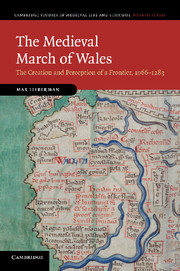Book contents
- Frontmatter
- Contents
- List of maps
- List of tables and illustration
- Preface
- List of abbreviations
- INTRODUCTION
- 1 A BORDER REGION?
- 2 THE MAKING OF A BORDER ARISTOCRACY
- 3 WARFARE AND DIPLOMACY
- 4 THE EXTENT AND NATURE OF THE MILITARY FRONTIER
- 5 THE MILITARIZATION OF SOCIETY
- 6 THE SHAPING OF ADMINISTRATIVE TERRITORIES
- 7 THE BORDER LORDSHIPS AND THE ENGLISH STATE
- CONCLUSION
- Select bibliography
- Index
2 - THE MAKING OF A BORDER ARISTOCRACY
Published online by Cambridge University Press: 06 July 2010
- Frontmatter
- Contents
- List of maps
- List of tables and illustration
- Preface
- List of abbreviations
- INTRODUCTION
- 1 A BORDER REGION?
- 2 THE MAKING OF A BORDER ARISTOCRACY
- 3 WARFARE AND DIPLOMACY
- 4 THE EXTENT AND NATURE OF THE MILITARY FRONTIER
- 5 THE MILITARIZATION OF SOCIETY
- 6 THE SHAPING OF ADMINISTRATIVE TERRITORIES
- 7 THE BORDER LORDSHIPS AND THE ENGLISH STATE
- CONCLUSION
- Select bibliography
- Index
Summary
The medieval concept of the March of Wales is closely linked to the Norman and English aristocratic families who held land in Wales and on the border. As was observed in the introduction, the March may have been perceived as a discrete territory because it was seen to coincide with the lands of a certain group of lords: those who had come, by the beginning of the thirteenth century, to be recognized as, and called, barones Marchie. The Welsh March was not exceptional in this respect. By 1172, the clerks of the English exchequer and chancery also referred to the frontier of Normandy as a marcha, and that ‘march’, too, was densely settled by local castellan families. Indeed, several familial links were forged, in the late eleventh and twelfth centuries, between the marches of Wales and of Normandy. Meanwhile, on the eastern limits of the Holy Roman Empire, new Markgrafen (margraves) were being established in the twelfth century, for instance in the Mark of Brandenburg. The contacts between the Plantagenets and Henry the Lion, the duke of Saxony, have already been mentioned. The idea that a ‘march’ was a territory under the command of a select group of border lords must have been current in twelfth- and thirteenth-century Britain. It is therefore indispensable to ask whether it could be said that the families of the Shropshire borders ‘shaped the March and, were, in turn, shaped by it’.
- Type
- Chapter
- Information
- The Medieval March of WalesThe Creation and Perception of a Frontier, 1066–1283, pp. 56 - 101Publisher: Cambridge University PressPrint publication year: 2010



